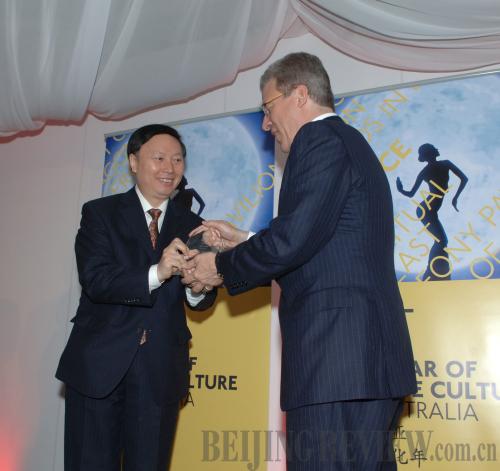|
 |
|
CELEBRATING COOPERATION: China's Vice Minister of Culture Yang Zhijin (left) presents a gift to Tom Albanese, Chief Executive of Rio Tinto, a partner of the Year of Chinese Culture in Australia, at the June 24 opening ceremony (JIANG YAPING) |
As the Year of Australian Culture in China drew to a close in June, the Year of Chinese Culture in Australia, titled Experience China, came on stage to showcase the rich variety of China's traditional and contemporary culture to the Australians.
The opening ceremony of the event was held on June 24 at the Sydney State Theater. It featured famous Chinese dancer Yang Liping's original dance drama The Legend of Shangri-La.
The Year of Chinese Culture in Australia is by far the largest Chinese cultural festival the Chinese Government has ever launched in Australia.
The year-long event consists of dozens of cultural activities ranging from dance, music and visual arts to seminars, exhibitions and film festivals.
A number of cultural institutions and art troupes from China will present some 300 art performances and exhibitions in major Australian cities including Sydney, Canberra, Melbourne, Brisbane, Adelaide and Perth.
Besides Yang's dance drama, highlights of the year's activities include ballet drama The Last Emperor by the Liaoning Ballet of China, Rhinoceros in Love by the National Theater of China and modern dance First Ritual—a joint performance by China's BeijingDance/LDTX and Australia's Expressions Dance Co.
Among other attractions are the National Ballet of China's ballet drama The Peony Pavilion and recitals by renowned pianist Lang Lang and Chinese violinist Li Chuanyun.
"We asked Australian artists for suggestions when selecting programs for the event," said Xu Tong, an official with the Bureau for External Cultural Relations of China's Ministry of Culture.
"They said Australian audiences prefer modern and contemporary pieces to traditional ones," Xu told a press conference in Beijing. "So we selected the most representative works showing Chinese people's lifestyles and aspirations today. All the works are popular in China, and we look forward to seeing them welcomed by Australian people."
The mutual culture years conducted by China and Australia are in response to a joint statement signed by the two countries when Chinese Vice Premier Li Keqiang visited Australia in 2009.
The cultural events are expected to strengthen friendly relations between China and Australia, as well as promote mutual understanding.
 |
|
CURIOUS MINDS: Australian secondary school students take part in a trivia contest about Chinese culture in Melbourne on June 23 (CAO YANG) |
In recent years, high-level official visits between the two countries have been frequent. With the deepening of mutual political trust, the expansion of economic and trade cooperation as well as the flourishing of exchanges in tourism, education, science and sports, the aspiration for mutual understanding has become prominent.
"Cultural exchange can bridge the gap between people of the two countries," said Wang Zhenyu, a researcher with the China National Committee for Pacific Economic Cooperation. "It helps Chinese and Australian people learn more about the history, culture and national conditions of each other, eliminate misunderstandings and develop a deep emotional bond."
Holding culture years—an important way of cultural exchange—will help consolidate the "popular basis" for Sino-Australian relations, Wang told Beijing Review.
Last June, the Year of Australian Culture in China was launched in Beijing. More than 200 activities featuring diverse Australian performances were staged in more than 30 cities in China, showcasing a dynamic, modern and multicultural Australia to Chinese people.
"The Year of Chinese Culture in Australia will be another chance to boost Sino-Australian ties," Wang said. "It will promote the movement of people between the two countries and stimulate bilateral trade. It may also set off a new surge of enthusiasm to learn Chinese in Australia and for Chinese students to study in Australia." | 